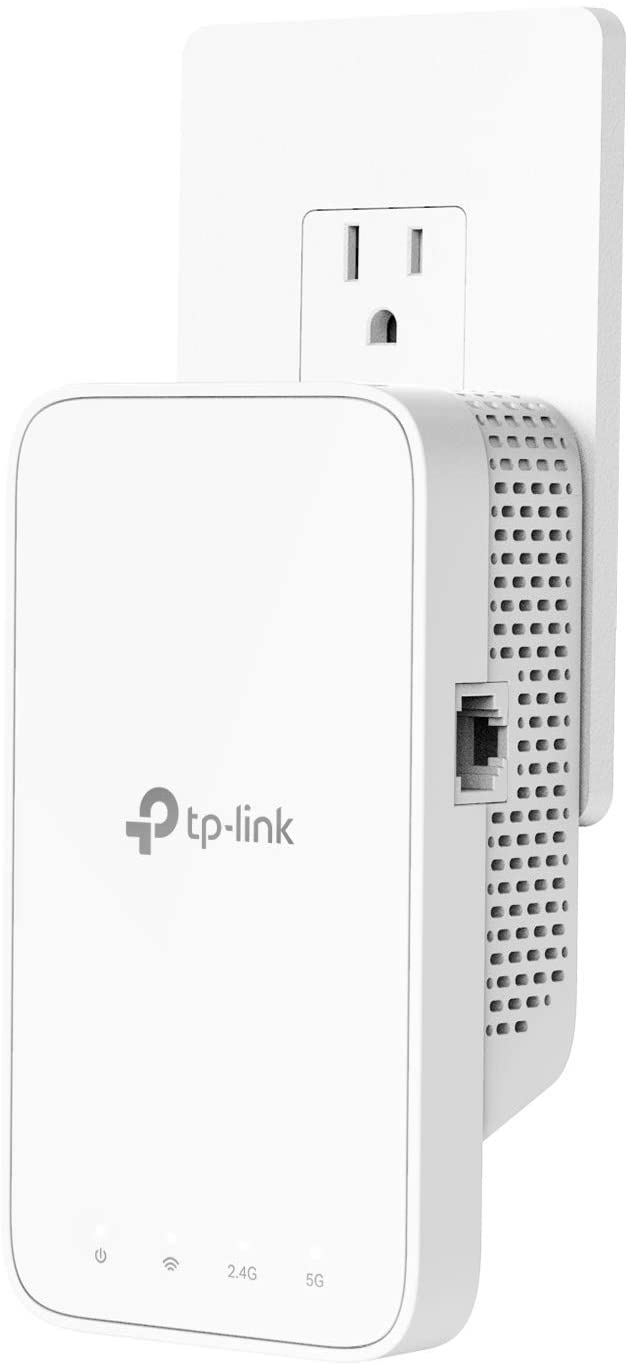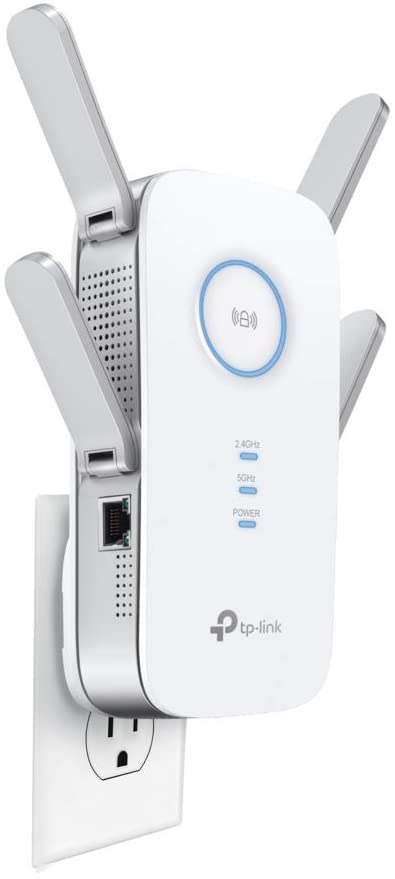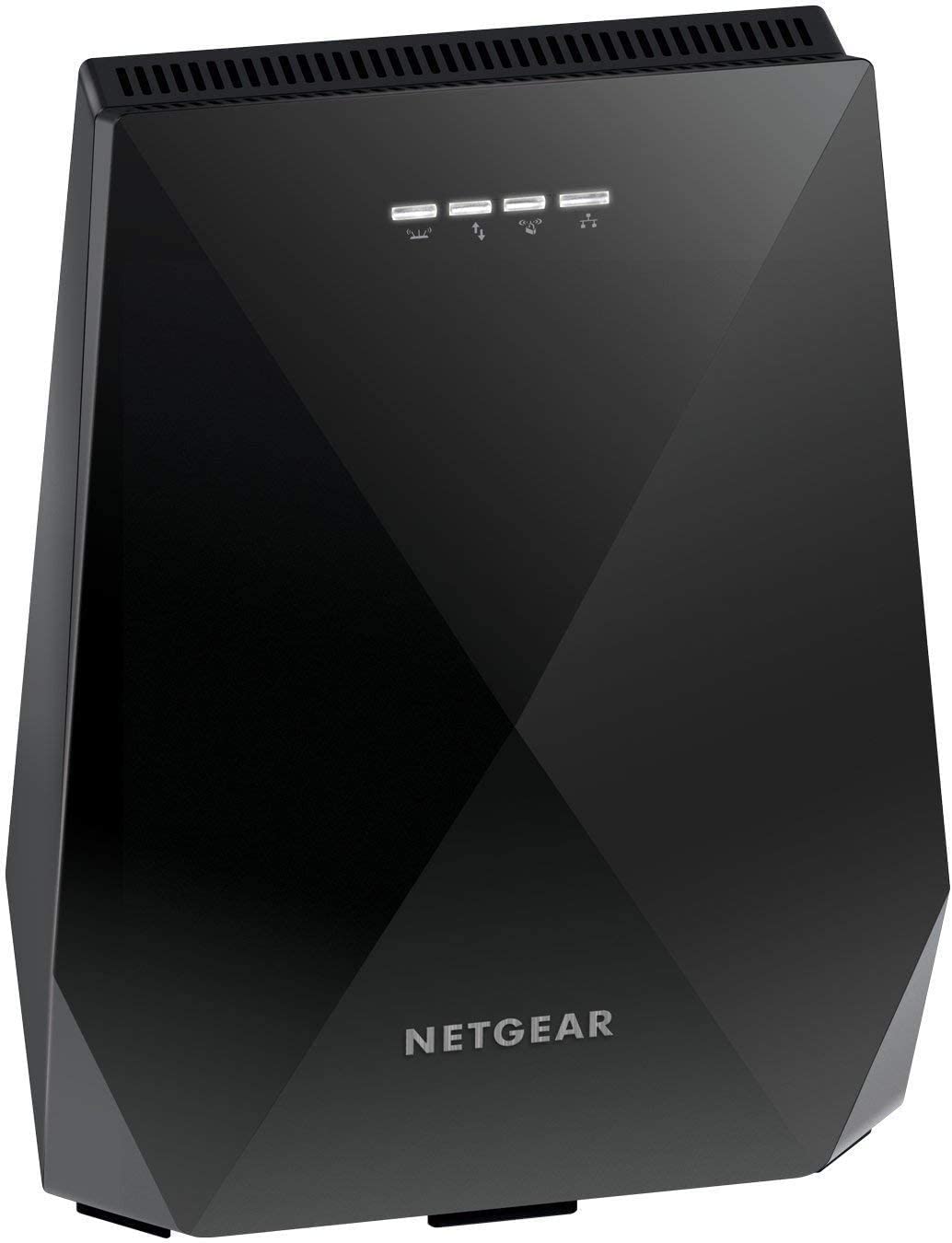The Best Wi-Fi Extenders for Your Money
Wi-Fi range extenders are devices that connect to a router, pick up its signal and rebroadcast it to areas where the signal usually doesn't reach.
These extenders, also known as Wi-Fi repeaters, are packed with internal or external antennas and can be plugged into the wall in strategic areas without occupying much space. They’re a good option to boost your network and significantly improve its quality and coverage, especially if multiple areas in your home have a weak (or no) Wi-Fi connection.
There are two main types of Wi-Fi repeaters: plug-in and desktop extenders. They both offer the same benefits; the main difference is the size.
Plug-in extenders are small and inserted into a wall outlet, like an air freshener or night light. Some models have external antennas, whereas others only have internal antennas for a lower-profile design. Because of their small size, plug-in extenders usually have only one Ethernet port.
Desktop extenders are larger, about the size of a router. They’re often equipped with external antennas as well as multiple Ethernet and USB ports. As their name suggests, they must be placed on a surface such as a desk or shelf.
Pricing varies depending on the type of range extender you choose and its capabilities. Plug-in extenders tend to be cheaper, retailing for anywhere between $30 to $150. Desktop extenders, on the other hand, range from $100 to over $200.
As you're shopping online, you may also come across generic "no-name" Wi-Fi extenders that can cost as little as $20. We don’t recommend these. Although they could work, they’re often less powerful and sold by obscure companies, and there’s no guarantee of getting a replacement or refund if there’s a manufacturing defect or malfunction. Plus, you can get a good range extender from a reputable manufacturer, such as Netgear, TP-Link, Linksys and D-Link, for about the same price or only a little more. So why take the risk?
Wi-Fi Extenders vs. Mesh Wi-Fi Systems
Before you decide to upgrade your Wi-Fi network with a range extender, consider whether a mesh system is a better fit for your home.
Mesh Wi-Fi systems combine a base router with multiple satellite modules. Together, they serve a similar function as having multiple range extenders connected to a router.
The main difference is that, unlike many extenders, mesh systems are part of a single Wi-Fi network and use the same SSID name and password. This means that your devices always stay connected to the same network even as you roam throughout your house.
Mesh systems are a great option for multi-story homes and houses that have thick walls and physical barriers. If that’s your situation, getting a mesh system may be a better option than buying multiple range extenders, since a mesh system will blanket your home with a seamless network. Plus, a mesh system is not that much more expensive than buying multiple extenders or a top-of-the-line extender with mesh capabilities. For instance, you can purchase a three-piece mesh system like the TP-Link Deco M5 for about $150, which will cover up to 5,500 square feet with an uninterrupted Wi-Fi signal.
But, if you live in a one-story house or apartment with an open floor plan, a range extender might be the best option, especially if your goal is simply to expand the Wi-Fi signal to one or two “dead” areas of your home. Also, Wi-Fi extenders are a more affordable option if you don’t want to invest in a mesh system that will probably cost over $200.
Wi-Fi Extender Buying Guide
Here are some factors to consider when shopping for the best Wi-Fi extender for your home:
• Compatibility. The Wi-Fi extender should be compatible with your router. The easiest way to find out is by checking your router specifications — specifically what type of Wi-Fi technology it supports.
Most extenders support either Wi-Fi 5 (802.11ac) or Wi-Fi 6 (802.11ax). Wi-Fi 5 extenders will include “AC” somewhere in the name, whereas those with the more advanced Wi-Fi 6 capability will have “AX.”
Both Wi-Fi 5 and Wi-Fi 6 devices are compatible with previous technologies, meaning they can work with any 802.11a/b/n/ac routers. However, while Wi-Fi 5 extenders work with previous generations, they don’t support Wi-Fi 6 performance. So if you own a Wi-Fi 6 router and purchase a Wi-Fi 5 extender, you risk getting lower speeds on all devices.
• Range. The Wi-Fi extender coverage area gives you an idea of how many square feet it can cover. You should consider not only the size of your home but also other factors such as wall thickness or interference from other devices.
Remember that Wi-Fi extenders must be placed somewhere in between the room where the router is located and the areas where you currently don’t receive wireless access (dead spots). If you live in a multi-story home, it’s possible you may need more than one extender. In that case, you may want to consider a mesh system instead.
• Frequency bands. Another important detail is whether the extender has two or three frequency bands. Frequency bands are used to distribute signal to your devices. Dual-band models have two frequency bands: 2.4GHz and 5GHz. Tri-band models, on the other hand, feature an additional 5GHz band.
The advantage of tri-band models is that they use the additional frequency band for "backhaul," that is, for communication directly with the router. This reduces bandwidth competition between devices, resulting in better speeds and connections.
• Speed. Wi-Fi extenders don’t make your internet faster. Nonetheless, to get the most out of it, the Wi-Fi extender's maximum speed should match the one advertised by your internet provider and the speed your router can deliver.
In other words, if you have a 1Gbps internet plan, your Wi-Fi extender should be able to handle speeds of at least 1Gbps (1,000Mbps) or even a bit more in case you eventually upgrade.
• Size. Even though most plug-in Wi-Fi extenders are compact and fit on a wall outlet, some can have external antennas or wider designs that may require you to sacrifice more than one free socket. If you already have other devices connected to the same power outlet, consider whether to buy a multiplug too.
Desktop extenders are typically the size of a regular wireless router, so you’ll need to figure out a good flat space for them.
• Ports. Most Wi-Fi extenders have Ethernet ports for wired connections. Plug-in extenders often only have one, but desktop extenders can feature up to five Ethernet ports and sometimes USB ports too. These ports are very useful to connect gaming consoles, smart TVs and devices that don’t support Wi-Fi connectivity, such as old desktop computers, laptops or printers.
The Best Wi-Fi Extenders of 2023
1. Best overall: Netgear Nighthawk AX6000 Mesh Range Extender
List Price: $249.99
Check on Amazon | Check on Walmart
Wi-Fi: Dual-Band 802.11ax (Wi-Fi 6) | Range: up to 2,500 sq. ft. | Speed: 6,000Mbps/6Gbps | Ports: 4 Ethernet ports, 1 USB
If you already own a router with the latest Wi-Fi 6 technology and need a powerful extender capable of reaching impressive speeds and performance, take a look at the Netgear Nighthawk EAX80.
This top-of-the-line range extender is packed with the latest features to deliver super-fast speeds and merge with your router easily. The EAX80 provides top speeds of 6,000Mbps (6Gbps), with a maximum 1,200Mbps on the 2.4GHz band and 4,800Mbps on the 5GHz. It can connect to over 30 devices and boost your Wi-Fi signal up to 2,500 square feet.
The EAX80 is also a mesh extender — in other words, it can connect with your router creating a single Wi-Fi network that shares the same name and password. This greatly improves coverage and allows you to stay connected to the closest and strongest Wi-Fi signal as you roam from room to room.
It’s also packed with multiple ports. It has one USB port and four Ethernet ports in the back, giving you plenty of options for connecting wired devices using Ethernet cables. This makes it easy to hook up laptops, smart TVs and game consoles, and get a faster connection to the network.
The Nighthawk EAX80 usually sells for over $200, making it one of the more expensive range extenders available on the market. Even though its powerful performance is worth the money, it could be overkill for many users, especially if your home is not equipped with the latest Wi-Fi 6 technology. It is, however, an investment in the future, since most newer devices will feature Wi-Fi 6 in the coming years.
Pros
- Features mesh capabilities to create one wireless network
- Includes multiple ports for USB and Ethernet
- Offers up to 2,500 square feet of coverage
- Delivers super-fast speeds
Cons
- Expensive at over $200
- Most useful for homes equipped with Wi-Fi 6
2. Editor’s pick: TP-Link AX1800 (RE605X) WiFi 6 Extender
List Price: $97.94
Check on Amazon | Check on Office Depot
Wi-Fi: Dual-band 802.11ax (Wi-Fi 6) | Range: up to 1,500 sq. ft. | Speed: 1,800Mbps/1.8Gbps | Ports: 1 Ethernet port
We like the TP-Link RE605X because it offers solid Wi-Fi 6 performance and requires little configuration, all for a reasonable price of about $100.
The RE605X is a dual-band plug-in extender that can handle 574Mbps on the 2.4GHz band and 1,201Mbps on the 5GHz band. So, depending on your network provider plan, you can get up to 1.8Gbps of data speed. As for network coverage, it goes up to 1,500 square feet and connects to up to 30 devices. Additionally, with the adaptive path selection feature, it can automatically choose the fastest connection for your devices, boosting speed for streaming and gaming.
The RE605X looks like a white brick, with two external antennas on the sides that can move 180° up and down. It has a WPS button on the sides that allows it to automatically connect with your router without having to do the manual setup process and an Ethernet port to connect wired devices, like gaming consoles. Do note that the RE605X is 6.23” long, which is relatively large, meaning it may block access to more than one power outlet.
Another advantage of the RE605X is that it features OneMesh, a technology that allows it to seamlessly connect with any compatible TP-Link router, such as the Archer AX20. This way you can create a mesh network around your house using a single Wi-Fi name and password. This promotes an uninterrupted and stable connection as you move around the house.
The setup process is quite simple and usually takes only a few minutes. You just connect the extender near the router, download the TP-Link Tether app and follow the steps until the extender is properly synced to the router. Once this is finished, you can move it to the area you want. The lights in front will let you know whether it’s well-placed or too far from the router.
Pros
- Easy configuration via mobile app
- Range of up to 1,500 square feet
- Ideal for boosting streaming and gaming speeds
- OneMesh technology for a single wireless network
Cons
- Compatible with specific router models
- Large size may block power outlet access
3. Best for low prices: TP-Link AC750 (RE230) WiFi Extender
List Price: $29.99
Wi-Fi: Dual-Band 802.11ac (Wi-Fi 5) | Range: up to 1,200 sq. ft. | Speed: 750Mbps | Ports: 1 Ethernet port
The TP-Link RE230 is not the fastest extender out there, but at around $30, it’s a highly affordable option for users who want to solve the problem of dead spots and are less concerned about fast file transfer.
Featuring a stylish understated design, the TP-Link RE230 packs two internal antennas to boost wireless connection by 1,200 square feet and deliver dual-band speeds of up to 750Mbps. It also comes with an Ethernet port.
The RE230 is about 5” long, very similar in size to an air freshener. It shouldn’t take up more than one power socket, and its white finish allows it to blend well with most home décor.
As with most TP-Link models, the setup process is simple. The RE230 must be plugged in near the router first. You then need to download the very user-friendly TP-Link app, which guides you through the whole process.
Pros
- Great price of $30 or less
- Simple setup process
- TP-Link app is very user-friendly
- Similar compact size to an air freshener
Cons
- Not the fastest extender available
- Only one Ethernet port
4. Best Wi-Fi extender for large homes: TP-Link AC2600 (RE650) WiFi Extender
List Price: $149.99
Check on Amazon | Check on Walmart
Wi-Fi: Dual-Band 802.11ac (Wi-Fi 5) | Coverage: up to 14,000 sq. ft. | Speed: 2,600Mbps/2.6Gbps | Ports: 1 Ethernet port
If you’re looking for a powerful plug-in Wi-Fi extender with outstanding performance and long coverage range, consider the TP-Link RE650.
It’s a dual-band Wi-Fi 5 extender that delivers a maximum data rate of 800Mbps on the 2.4GHz and 1,733Mbps on the 5GHz band. With four external antennas, it can expand Wi-Fi coverage up to a whopping 14,000 square feet and streamline data delivery using its 880MHz dual-core CPU. This is enough power to keep a steady connection even with multiple users on the network at the same time, even with 4K streaming and gaming.
What’s best is that it supports MU-MIMO (multiple-user, multiple input, multiple output), a technology that allows it to simultaneously send data to up to four devices and receive data back. This helps reduce wait time and achieve speeds that are four times faster than standard extenders. However, your router should be MU-MIMO compatible to take full advantage of this capability.
The RE650 uses an LED light indicator to help you find the best spot for it and alert you to any connectivity issues. If the light is red, the extender is too far away from the router; a blue light, on the other hand, indicates there’s a good connection. A button on the side lets you turn the light off so it doesn’t bother you at night.
Bear in mind that the TP-Link RE650 is rather large. It measures around 7” — about the same size as a smartphone — and has four antennas, which means it’ll take up more than one power outlet. This may be a drawback if you don’t have many outlets available, in which case you might need to consider buying a multiplug.
Pros
- Huge range coverage, up to 14,000 square feet
- LED light indicator for monitoring status
- Speeds are four times faster than standard models
- Data delivery of up to four devices simultaneously
Cons
- Large design may block power outlet access
- Best used with an MU-MIMO-compatible router
5. Best Wi-Fi 5 range extender: Netgear Nighthawk AC2200 X6 (EX7700)
List Price: $159.99
Check on Amazon | Check on Walmart
Wi-Fi: Tri-Band 802.11ac (Wi-Fi 5) | Coverage: up to 2,300 sq. ft. | Speed: 2,200Mbps/2.2Gbps | Ports: 2 Ethernet ports
The Netgear Nighthawk X6 is a great choice for users who want to extend their coverage area and create a seamless Wi-Fi network.
This tri-band extender features one 400Mbps 2.4GHz band and two 866Mbps 5GHz bands. It can deliver a maximum speed rate of 2,200Mbps (or 2.2Gbps) and cover up to 2,300 square feet. It also has a dedicated 5GHz band for backhaul, that is, direct communication between the extender and the router, which can help maximize bandwidth.
One major selling point of the Nighthawk X6 is its mesh system capabilities. This means that it can connect with your router and other similar extenders to work together as one Wi-Fi network with the same SSID name and password. Ultimately, this allows your devices to automatically switch to the best network and stay connected as you move around.
The setup process is quite simple. It connects in one of three ways: through the Netgear Assistant on the web browser, using the Nighthawk app or by pressing the WPS button on the back panel. The latter automatically connects to your Wi-Fi network if you own a WPS-enabled router.
Once the initial setup is complete you can move the unit to a halfway point between the router and the dead spot. An LED light in the front panel will let you know whether it’s in a good spot or too far away.
At around $160, the Nighthawk X6 is a bit pricey compared to other extenders. However, its reliable performance and advanced mesh networking abilities make it a great deal.
If you prefer a wall-plug extender instead, consider the Netgear Nighthawk AC2200 X4S (EX7500). It has the same capabilities as the EX7700, in terms of speed and coverage, but doesn’t have Ethernet ports. Usually, it costs $20 more than the Nighthawk EX7700, but it's sometimes available for under $100.
Pros
- Includes two Ethernet ports for wired devices
- Offers mesh network capabilities
- Covers up to 2,300 square feet
- Features an LED light for optimal positioning
Cons
- High list price, typically around $160
- Not as compact as a wall-plug extender
Why Trust Us
Our commitment to the consumer begins with product selection and ends with the last word we write in each article. Each Wi-Fi extender is carefully vetted quantitatively through star ratings and the number of reviews and qualitatively through careful examination of reviews and the features each one has to offer. Leveraging our team of bargain hunters, we’re always sure to keep your budget in mind while finding the best Wi-Fi extenders on the market. Our team of experts is dedicated to accurately depicting the pros and cons of each Wi-Fi extender, translating technical product specifications into information you can understand. We aim to provide you with the most effective home network tools on the market.
More From Money:
The Best Mesh Wi-Fi Systems for Your Money
The Best Modems and Routers for Your Money, According to IT Pros




